tire pressure TOYOTA GT86 2012 Owners Manual
[x] Cancel search | Manufacturer: TOYOTA, Model Year: 2012, Model line: GT86, Model: TOYOTA GT86 2012Pages: 448, PDF Size: 13.47 MB
Page 4 of 448
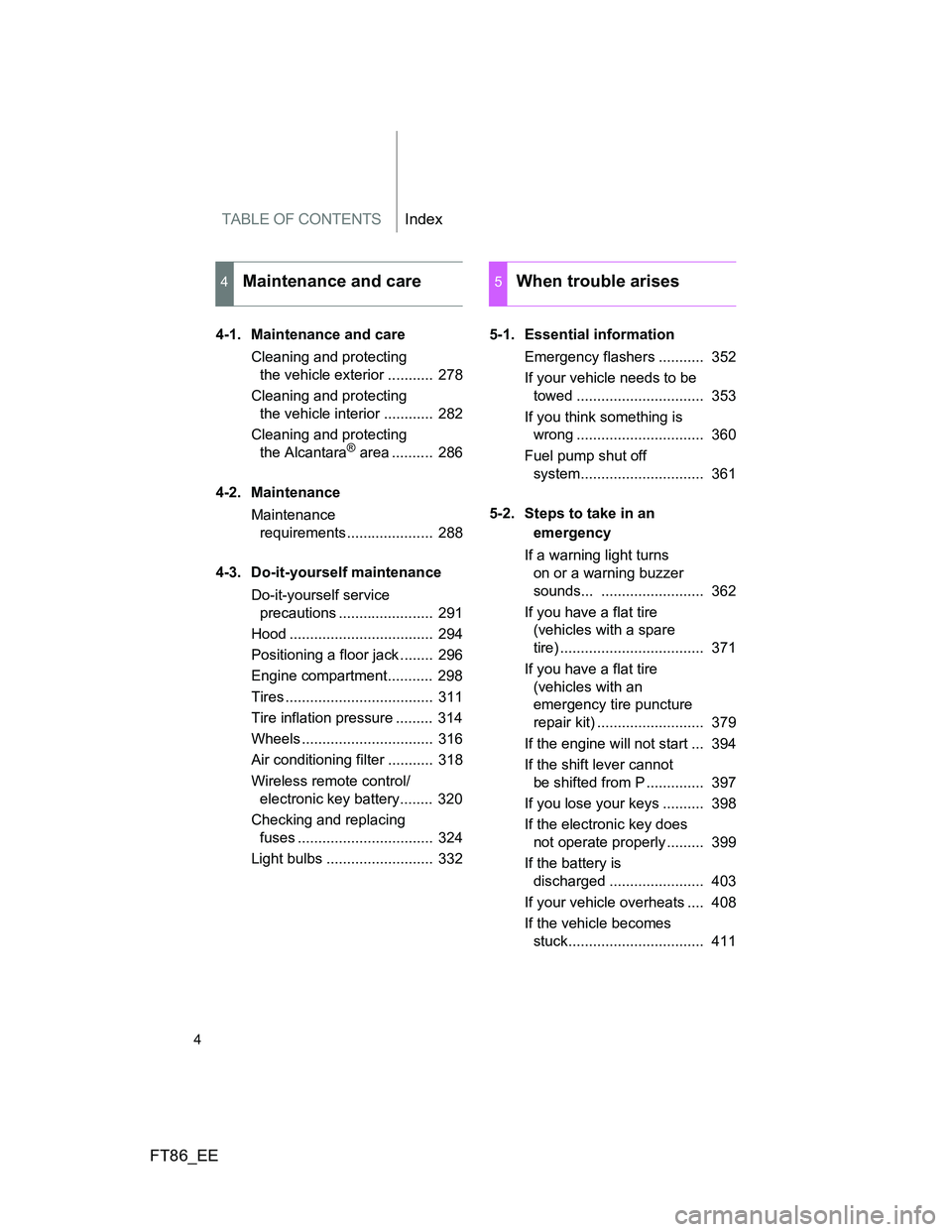
TABLE OF CONTENTSIndex
FT86_EE
4
4-1. Maintenance and care
Cleaning and protecting
the vehicle exterior ........... 278
Cleaning and protecting
the vehicle interior ............ 282
Cleaning and protecting
the Alcantara
® area .......... 286
4-2. Maintenance
Maintenance
requirements..................... 288
4-3. Do-it-yourself maintenance
Do-it-yourself service
precautions ....................... 291
Hood ................................... 294
Positioning a floor jack ........ 296
Engine compartment........... 298
Tires .................................... 311
Tire inflation pressure ......... 314
Wheels ................................ 316
Air conditioning filter ........... 318
Wireless remote control/
electronic key battery........ 320
Checking and replacing
fuses ................................. 324
Light bulbs .......................... 3325-1. Essential information
Emergency flashers ........... 352
If your vehicle needs to be
towed ............................... 353
If you think something is
wrong ............................... 360
Fuel pump shut off
system.............................. 361
5-2. Steps to take in an
emergency
If a warning light turns
on or a warning buzzer
sounds... ......................... 362
If you have a flat tire
(vehicles with a spare
tire) ................................... 371
If you have a flat tire
(vehicles with an
emergency tire puncture
repair kit) .......................... 379
If the engine will not start ... 394
If the shift lever cannot
be shifted from P .............. 397
If you lose your keys .......... 398
If the electronic key does
not operate properly ......... 399
If the battery is
discharged ....................... 403
If your vehicle overheats .... 408
If the vehicle becomes
stuck................................. 411
4Maintenance and care5When trouble arises
Page 7 of 448
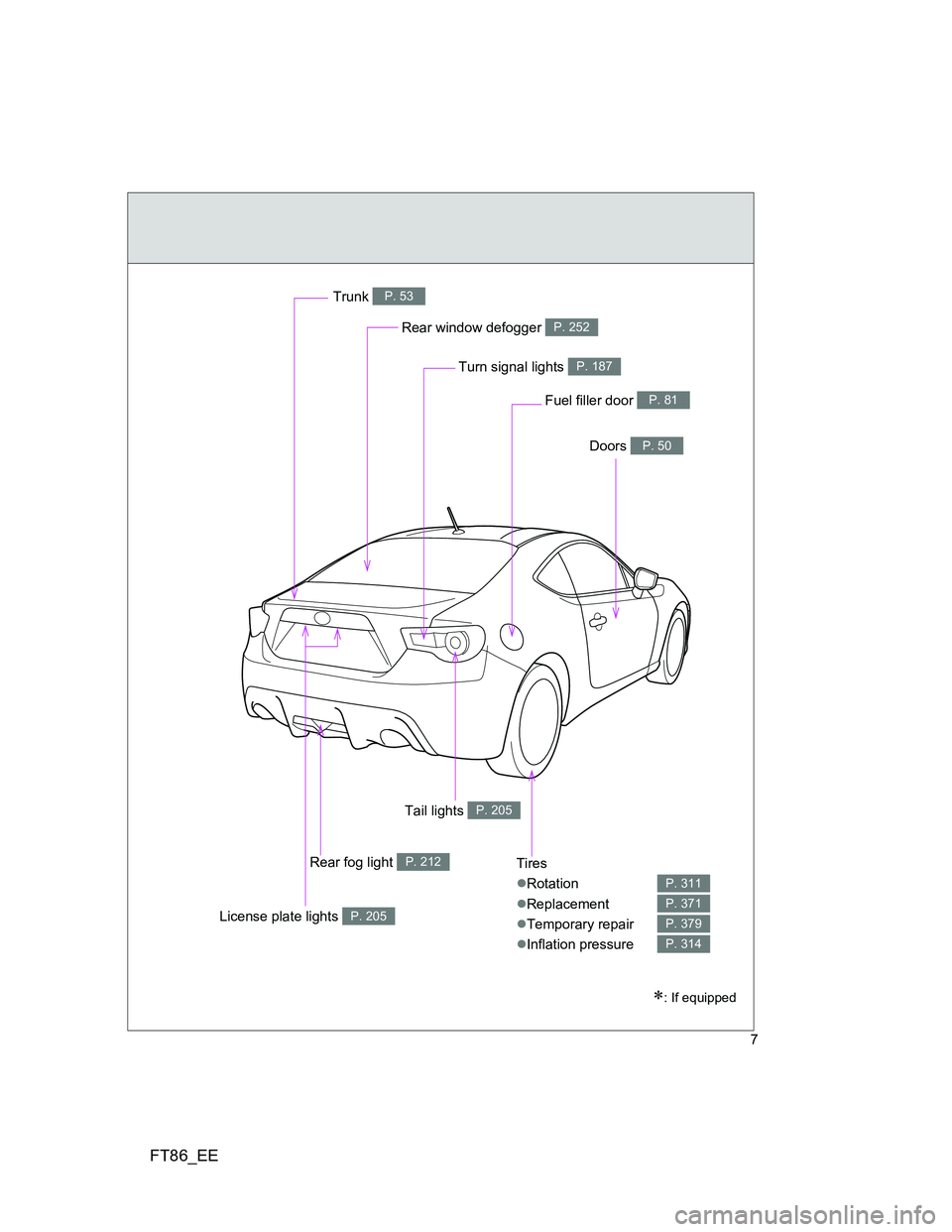
FT86_EE
7
Tires
Rotation
Replacement
Temporary repair
Inflation pressure
P. 311
P. 371
P. 379
P. 314
Rear window defogger P. 252
Trunk P. 53
Doors P. 50
Fuel filler door P. 81
Turn signal lights P. 187
: If equipped
License plate lights P. 205
Tail lights P. 205
Rear fog light P. 212
Page 226 of 448
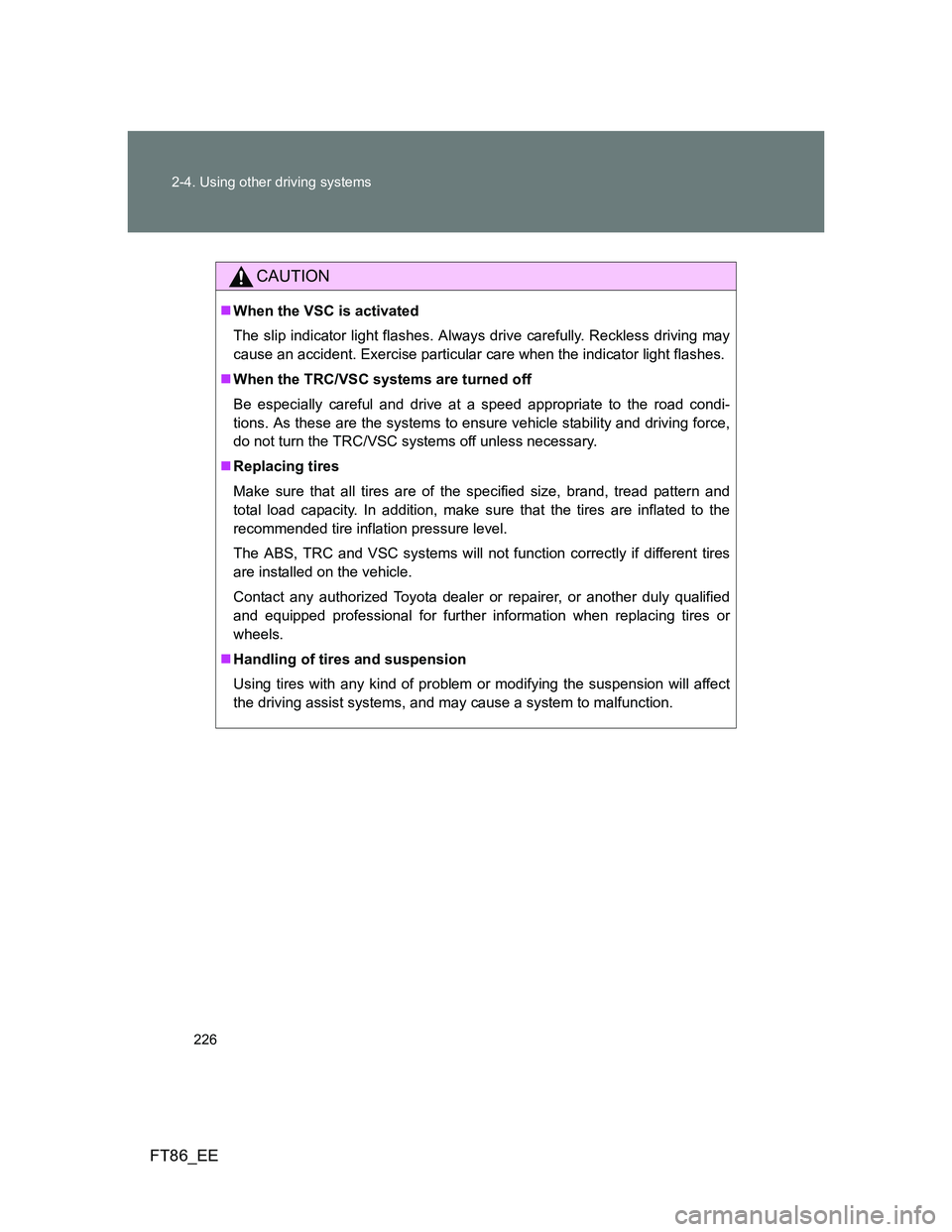
226 2-4. Using other driving systems
FT86_EE
CAUTION
When the VSC is activated
The slip indicator light flashes. Always drive carefully. Reckless driving may
cause an accident. Exercise particular care when the indicator light flashes.
When the TRC/VSC systems are turned off
Be especially careful and drive at a speed appropriate to the road condi-
tions. As these are the systems to ensure vehicle stability and driving force,
do not turn the TRC/VSC systems off unless necessary.
Replacing tires
Make sure that all tires are of the specified size, brand, tread pattern and
total load capacity. In addition, make sure that the tires are inflated to the
recommended tire inflation pressure level.
The ABS, TRC and VSC systems will not function correctly if different tires
are installed on the vehicle.
Contact any authorized Toyota dealer or repairer, or another duly qualified
and equipped professional for further information when replacing tires or
wheels.
Handling of tires and suspension
Using tires with any kind of problem or modifying the suspension will affect
the driving assist systems, and may cause a system to malfunction.
Page 231 of 448
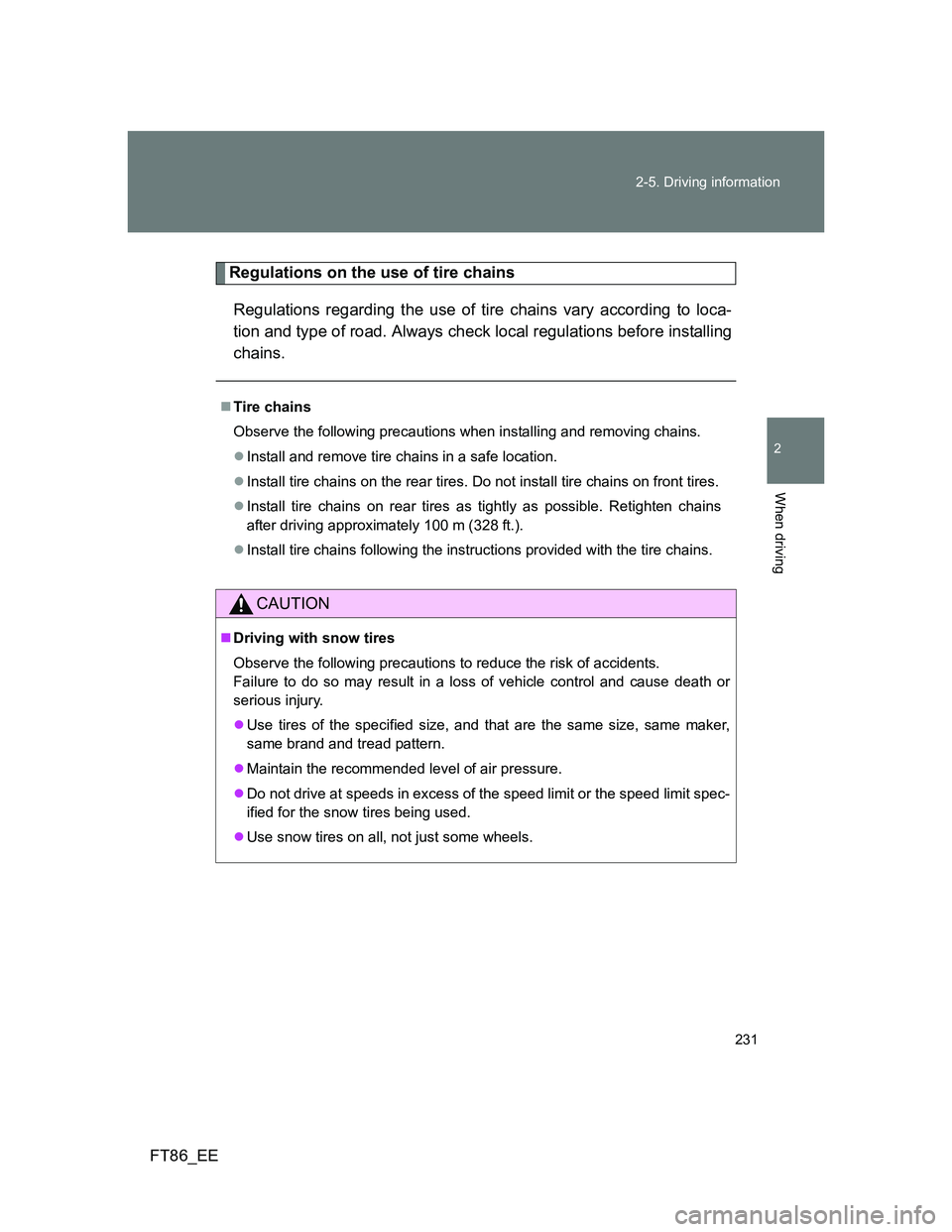
231 2-5. Driving information
2
When driving
FT86_EE
Regulations on the use of tire chains
Regulations regarding the use of tire chains vary according to loca-
tion and type of road. Always check local regulations before installing
chains.
Tire chains
Observe the following precautions when installing and removing chains.
Install and remove tire chains in a safe location.
Install tire chains on the rear tires. Do not install tire chains on front tires.
Install tire chains on rear tires as tightly as possible. Retighten chains
after driving approximately 100 m (328 ft.).
Install tire chains following the instructions provided with the tire chains.
CAUTION
Driving with snow tires
Observe the following precautions to reduce the risk of accidents.
Failure to do so may result in a loss of vehicle control and cause death or
serious injury.
Use tires of the specified size, and that are the same size, same maker,
same brand and tread pattern.
Maintain the recommended level of air pressure.
Do not drive at speeds in excess of the speed limit or the speed limit spec-
ified for the snow tires being used.
Use snow tires on all, not just some wheels.
Page 277 of 448

4Maintenance and care
277
FT86_EE
4-1. Maintenance and care
Cleaning and protecting
the vehicle exterior ......... 278
Cleaning and protecting
the vehicle interior .......... 282
Cleaning and protecting
the Alcantara
® area ........ 286
4-2. Maintenance
Maintenance
requirements................... 288
4-3. Do-it-yourself maintenance
Do-it-yourself service
precautions ..................... 291
Hood ................................. 294
Positioning a floor jack ...... 296
Engine compartment......... 298
Tires .................................. 311
Tire inflation pressure ....... 314
Wheels .............................. 316
Air conditioning filter ......... 318
Wireless remote control/
electronic key battery...... 320
Checking and replacing
fuses ............................... 324
Light bulbs ........................ 332
Page 292 of 448
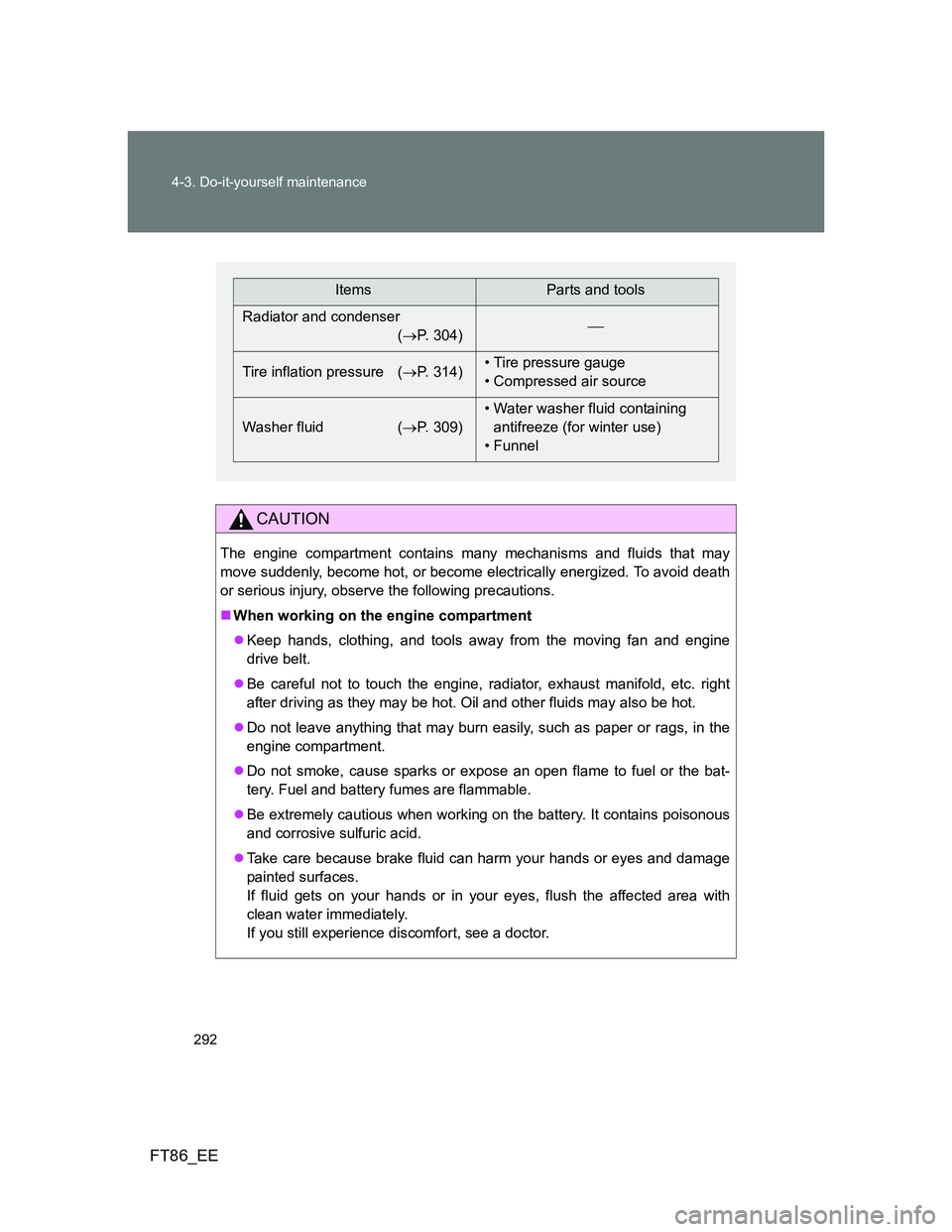
292 4-3. Do-it-yourself maintenance
FT86_EE
CAUTION
The engine compartment contains many mechanisms and fluids that may
move suddenly, become hot, or become electrically energized. To avoid death
or serious injury, observe the following precautions.
When working on the engine compartment
Keep hands, clothing, and tools away from the moving fan and engine
drive belt.
Be careful not to touch the engine, radiator, exhaust manifold, etc. right
after driving as they may be hot. Oil and other fluids may also be hot.
Do not leave anything that may burn easily, such as paper or rags, in the
engine compartment.
Do not smoke, cause sparks or expose an open flame to fuel or the bat-
tery. Fuel and battery fumes are flammable.
Be extremely cautious when working on the battery. It contains poisonous
and corrosive sulfuric acid.
Take care because brake fluid can harm your hands or eyes and damage
painted surfaces.
If fluid gets on your hands or in your eyes, flush the affected area with
clean water immediately.
If you still experience discomfort, see a doctor.
ItemsParts and tools
Radiator and condenser
(P. 304)
Tire inflation pressure (P. 314)• Tire pressure gauge
• Compressed air source
Washer fluid (P. 309)• Water washer fluid containing
antifreeze (for winter use)
• Funnel
Page 311 of 448

311
4-3. Do-it-yourself maintenance
4
Maintenance and care
FT86_EE
Tires
Replace or rotate tires in accordance with maintenance schedules
and treadwear.
Checking tires
New tread
Treadwear indicator
Worn tread
The location of treadwear indi-
cators is shown by the “TWI” or
“ ” marks, etc., molded on
the sidewall of each tire.
Check spare tire condition and
pressure if not rotated.
Tire rotation
Vehicles with an emergency tire puncture repair kit
Rotate the tires in the order
shown.
To equalize tire wear and help
extend tire life, Toyota recom-
mends that tire rotation is car-
ried out approximately every
10000 km (6000 miles).
Front
Page 313 of 448
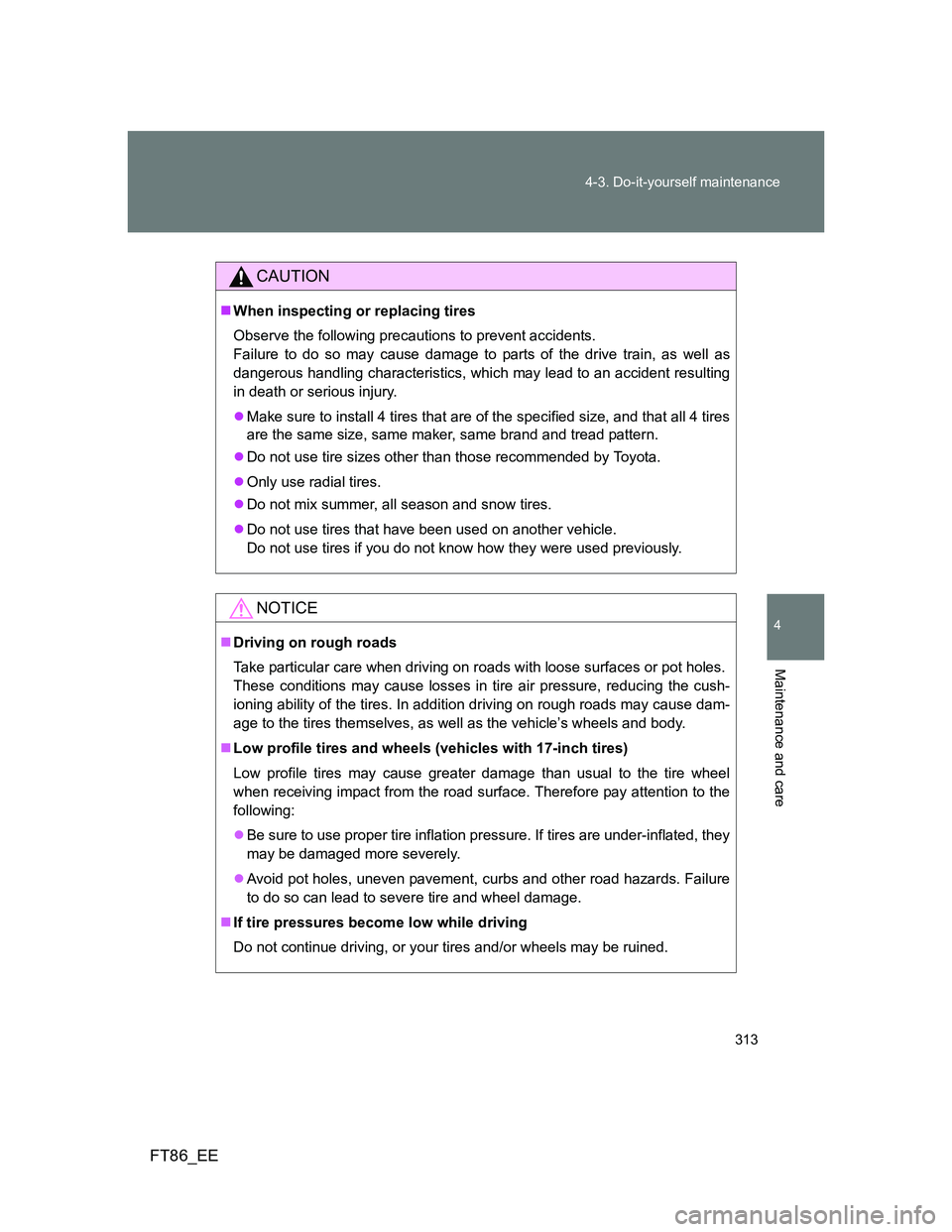
313 4-3. Do-it-yourself maintenance
4
Maintenance and care
FT86_EE
CAUTION
When inspecting or replacing tires
Observe the following precautions to prevent accidents.
Failure to do so may cause damage to parts of the drive train, as well as
dangerous handling characteristics, which may lead to an accident resulting
in death or serious injury.
Make sure to install 4 tires that are of the specified size, and that all 4 tires
are the same size, same maker, same brand and tread pattern.
Do not use tire sizes other than those recommended by Toyota.
Only use radial tires.
Do not mix summer, all season and snow tires.
Do not use tires that have been used on another vehicle.
Do not use tires if you do not know how they were used previously.
NOTICE
Driving on rough roads
Take particular care when driving on roads with loose surfaces or pot holes.
These conditions may cause losses in tire air pressure, reducing the cush-
ioning ability of the tires. In addition driving on rough roads may cause dam-
age to the tires themselves, as well as the vehicle’s wheels and body.
Low profile tires and wheels (vehicles with 17-inch tires)
Low profile tires may cause greater damage than usual to the tire wheel
when receiving impact from the road surface. Therefore pay attention to the
following:
Be sure to use proper tire inflation pressure. If tires are under-inflated, they
may be damaged more severely.
Avoid pot holes, uneven pavement, curbs and other road hazards. Failure
to do so can lead to severe tire and wheel damage.
If tire pressures become low while driving
Do not continue driving, or your tires and/or wheels may be ruined.
Page 314 of 448
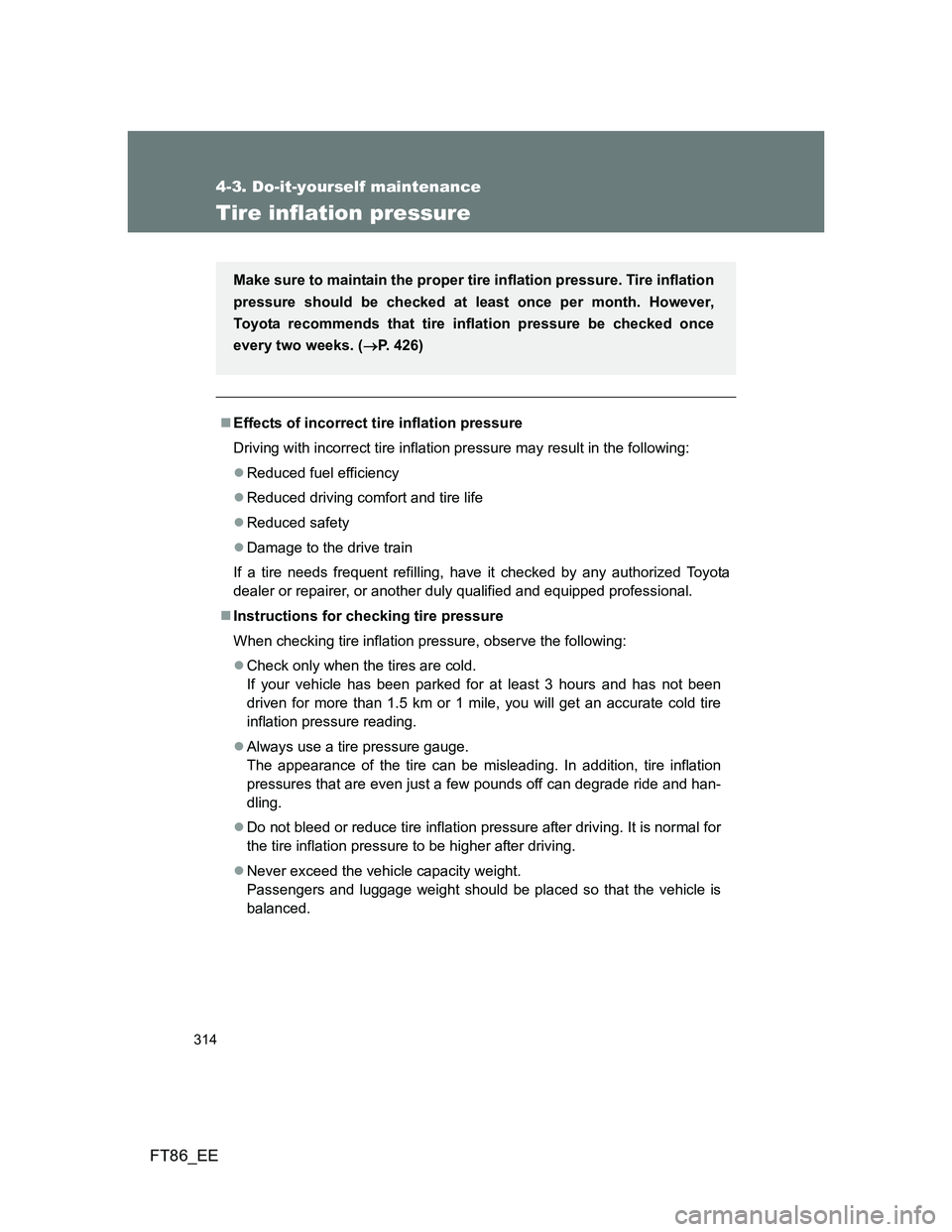
314
4-3. Do-it-yourself maintenance
FT86_EE
Tire inflation pressure
Effects of incorrect tire inflation pressure
Driving with incorrect tire inflation pressure may result in the following:
Reduced fuel efficiency
Reduced driving comfort and tire life
Reduced safety
Damage to the drive train
If a tire needs frequent refilling, have it checked by any authorized Toyota
dealer or repairer, or another duly qualified and equipped professional.
Instructions for checking tire pressure
When checking tire inflation pressure, observe the following:
Check only when the tires are cold.
If your vehicle has been parked for at least 3 hours and has not been
driven for more than 1.5 km or 1 mile, you will get an accurate cold tire
inflation pressure reading.
Always use a tire pressure gauge.
The appearance of the tire can be misleading. In addition, tire inflation
pressures that are even just a few pounds off can degrade ride and han-
dling.
Do not bleed or reduce tire inflation pressure after driving. It is normal for
the tire inflation pressure to be higher after driving.
Never exceed the vehicle capacity weight.
Passengers and luggage weight should be placed so that the vehicle is
balanced.
Make sure to maintain the proper tire inflation pressure. Tire inflation
pressure should be checked at least once per month. However,
Toyota recommends that tire inflation pressure be checked once
every two weeks. (P. 426)
Page 315 of 448
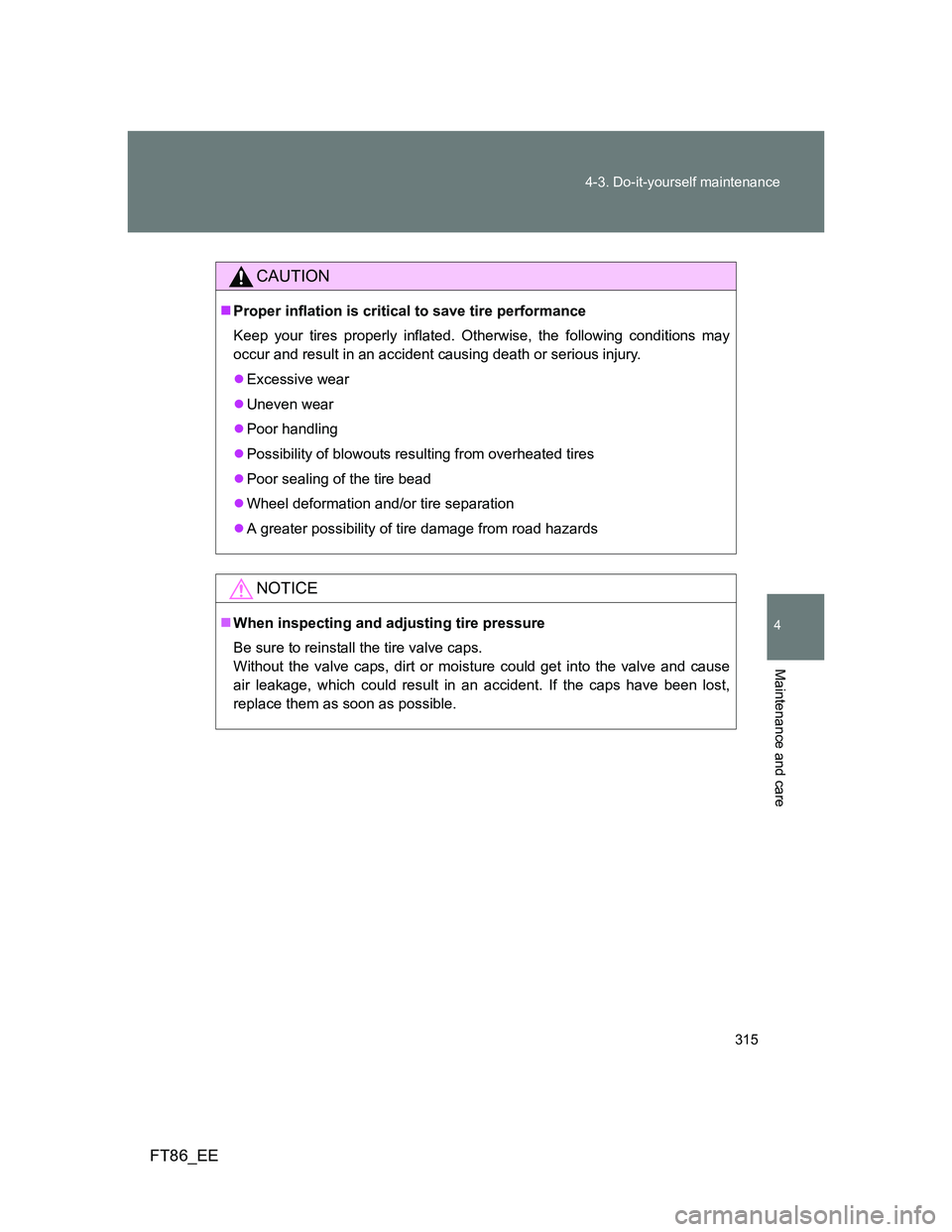
315 4-3. Do-it-yourself maintenance
4
Maintenance and care
FT86_EE
CAUTION
Proper inflation is critical to save tire performance
Keep your tires properly inflated. Otherwise, the following conditions may
occur and result in an accident causing death or serious injury.
Excessive wear
Uneven wear
Poor handling
Possibility of blowouts resulting from overheated tires
Poor sealing of the tire bead
Wheel deformation and/or tire separation
A greater possibility of tire damage from road hazards
NOTICE
When inspecting and adjusting tire pressure
Be sure to reinstall the tire valve caps.
Without the valve caps, dirt or moisture could get into the valve and cause
air leakage, which could result in an accident. If the caps have been lost,
replace them as soon as possible.